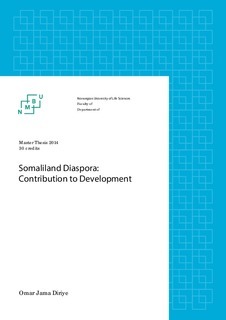| dc.description.abstract | This study focuses on the diaspora contribution to the development of Somaliland. In
detail three types of remittances are examined as well as Hawala operators particularly the
strategies behind employment and taxation toward Hawala is examined.
In order to obtain the needed data to the study, qualitative and quantitative research
methods were applied. The study separated the focus groups into three respondents groups.
The first focus group is the family remittance recipients and 90 families were interviewed,
using structural questions and discussions to obtain proper data regarding the use of
remittance and its effects. The second group contains 10 diaspora owned business including to
Hawalas using structural interview with managers and the obtained data is toward
employment and their other contribution to development. The third focus group is the state
owned institutions and this part of the study has examined the overall diaspora contribution to
humanitarian and development terms.
The study finds that the family remittance recipients benefit from the remittance in
terms of some savings, creating other income generating activities including new migration of
the members of the recipients. As there is huge unemployment in the region, new migration
has the potential that the recipients have sustainable remittances and the migration is
strategically planed and intended to be income diversification. When it comes to the
investments from the diaspora, this study finds that the non-recipients can’t benefit this type
of remittance due to the employing strategies from the owners given the fact that family and
clan members of the owner have the opportunity of employment. Another remittance
examined in this study is collective remittance to public goods and finds that the Diasporas
organizations are based on clan, and although they contribute to humanitarian aid however
there capacity are meager.
The study concludes that the non-recipients in general and the members of
marginalized clans in the region with less members abroad can’t benefit from remittances
significantly and there is huge unequal distribution of remittances. | nb_NO |

